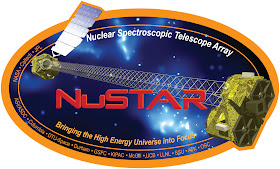NASA - Lunar Atmosphere and Dust Environment Explorer (LADEE) logo.
Sept. 7, 2013
Image above: Photograph of LADEE's launch aboard a Minotaur V on Sept. 6, 2013. Image credit: NASA Wallops/Chris Perry.
NASA has confirmed its Lunar Atmosphere and Dust Environment Explorer (LADEE) has separated from its ride into space, powered up and is communicating with ground controllers following a successful launch at 11:27 p.m. EDT Friday, Sept. 6, from the agency's Wallops Flight Facility in Virginia. LADEE is on its way to arrive at the moon in 30 days, then enter lunar orbit.
According to the LADEE mission operations team at NASA's Ames Research Center in Moffett Field, Calif., during technical checkouts the LADEE spacecraft commanded itself to shut down the reaction wheels used to position and stabilize the spacecraft.
LADEE Launches!
"The LADEE spacecraft is working as it was designed to under these conditions – there's no indication of anything wrong with the reaction wheels or spacecraft," said S. Pete Worden, Ames center director. "The LADEE spacecraft is communicating and is very robust. The mission team has ample time to resolve this issue before the spacecraft reaches lunar orbit. We don't have to do anything in a rush."
LADEE team members are currently analyzing the situation. Normal checkout takes a couple of days, and this anomaly may add a couple more days to the process.
"This is not an unusual event in spacecraft," Worden said. "We plan in the next few days to complete spacecraft checkout."
NASA's Lunar Atmosphere and Dust Environment Explorer (LADEE), managed by NASA's Ames Research Center in Moffett Field, Calif., launched at 11:27 p.m. EDT on Sept. 6 from Pad 0B at the Mid-Atlantic Regional Spaceport, at NASA's Wallops Flight Facility, Wallops Island, Va.
NASA's Lunar Atmosphere and Dust Environment Explorer (LADEE)
NASA's Lunar Atmosphere and Dust Environment Explorer (LADEE, pronounced like "laddie") is a robotic mission that will orbit the moon to gather detailed information about the lunar atmosphere, conditions near the surface and environmental influences on lunar dust. A thorough understanding of these characteristics will address long-standing unknowns, and help scientists understand other planetary bodies as well.
What is LADEE?
NASA's Lunar Atmosphere and Dust Environment Explorer (LADEE) is a robotic mission that will orbit the moon to gather detailed information about the lunar atmosphere, conditions near the surface and environmental influences on lunar dust. A thorough understanding of these characteristics will address long-standing unknowns, and help scientists understand other planetary bodies as well.
NASA’s Lunar Mission: Testing a Multi-Use Spacecraft Design
The LADEE spacecraft's modular common spacecraft bus, or body, is an innovative way of transitioning away from custom designs and toward multi-use designs and assembly-line production, which could drastically reduce the cost of spacecraft development, just as the Ford Model T did for automobiles. NASA's Ames Research Center designed, developed, built and tested the spacecraft.
LADEE press kit now available [24 MB PDF]: http://www.nasa.gov/sites/default/files/files/LADEE-Press-Kit-08292013.pdf
For more information about NASA's Lunar Atmosphere and Dust Environment Explorer (LADEE), visit: http://www.nasa.gov/mission_pages/ladee/main/index.html
Images, Video, Text, Credit: NASA / NASA TV.
Best regards, Orbiter.ch
























